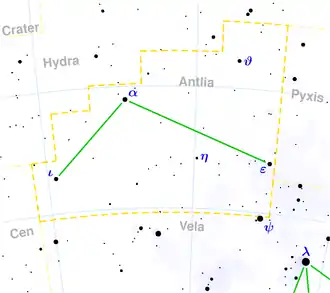Eta Antliae
η Antliae (Eta Antliae, kurz η Ant) ist der fünfthellste Stern des Sternbildes Luftpumpe. Er ist ein für das bloße Auge unter guten Sichtbedingungen gerade noch sichtbares Objekt mit der scheinbaren Helligkeit von 5,22 mag.[2] Die Entfernung dieses gelbweißlich leuchtenden Hauptreihensterns der Spektralklasse F1[3] von der Erde beträgt nach den neuesten Auswertungen der Messergebnisse der Raumsonde Gaia 108,5 Lichtjahre.[1] Er ist etwa 55 % massereicher als die Sonne,[5] weist eine Größe von circa 1,72 Sonnendurchmesser auf[6] und besitzt eine effektive Temperatur von rund 7130 K.[3] Auch bildet er wohl mit einem in 31 Bogensekunden Entfernung stehenden lichtschwachen Begleiter der scheinbaren Helligkeit 11,3m ein physisches Doppelsternsystem.[7]
| Stern Eta Antliae | |||||||||||||
|---|---|---|---|---|---|---|---|---|---|---|---|---|---|
| |||||||||||||
| AladinLite | |||||||||||||
| Beobachtungsdaten Äquinoktium: J2000.0, Epoche: J2000.0 | |||||||||||||
| Sternbild | Luftpumpe | ||||||||||||
| Rektaszension | 09h 58m 52,28s [1] | ||||||||||||
| Deklination | –35° 53′ 27,5″ [1] | ||||||||||||
| Helligkeiten | |||||||||||||
| Scheinbare Helligkeit | 5,22 mag [2] | ||||||||||||
| Spektrum und Indices | |||||||||||||
| B−V-Farbindex | 0,333 [2] | ||||||||||||
| U−B-Farbindex | 0,068 [2] | ||||||||||||
| Spektralklasse | F1 V [3] | ||||||||||||
| Astrometrie | |||||||||||||
| Radialgeschwindigkeit | (30.0 ± 4.2) km/s [4] | ||||||||||||
| Parallaxe | (30.0499 ± 0.0776) mas [1] | ||||||||||||
| Entfernung | (108.5 ± 0.3) Lj (33.3 ± 0.1) pc [1] | ||||||||||||
| Visuelle Absolute Helligkeit Mvis | 2,61 mag [Anm 1] | ||||||||||||
| Eigenbewegung [1] | |||||||||||||
| Rek.-Anteil: | (−89.728 ± 0.051) mas/a | ||||||||||||
| Dekl.-Anteil: | (−15.945 ± 0.055) mas/a | ||||||||||||
| Physikalische Eigenschaften | |||||||||||||
| Masse | 1.55 M☉ [5] | ||||||||||||
| Radius | 1.72 R☉ [6] | ||||||||||||
| Leuchtkraft | |||||||||||||
| Effektive Temperatur | 7132 K [3] | ||||||||||||
| Alter | 900 Millionen a [5] | ||||||||||||
| Andere Bezeichnungen und Katalogeinträge | |||||||||||||
| |||||||||||||
| Anmerkung | |||||||||||||
| |||||||||||||
Einzelnachweise
- Gaia early data release 3 (Gaia EDR3), Dezember 2020
- Adelina Gutierrez-Moreno, H. Moreno, J. Stock, C. Torres, H. Wroblewski: A System of photometric standards. In: Publicaciones Universidad de Chile, Department de Astronomy. 1, 1966, S. 1–17. bibcode:1966PDAUC...1....1G.
- R. O. Gray, C. J. Corbally, R. F. Garrison, M. T. McFadden, E. J. Bubar, C. E. McGahee, A. A. O'Donoghue, E. R. Knox: Contributions to the Nearby Stars (NStars) Project: spectroscopy of stars earlier than M0 within 40 pc-The Southern Sample. In: The Astronomical Journal. 132, Nr. 1, July 2006, S. 161–170. arxiv:astro-ph/0603770. bibcode:2006AJ....132..161G. doi:10.1086/504637. (Datensatz auf VizieR)
- G. A. Gontcharov: Pulkovo Compilation of Radial Velocities for 35 495 Hipparcos stars in a common system. In: Astronomy Letters. 32, November 2006, S. 759–771. arxiv:1606.08053. bibcode:2006AstL...32..759G. doi:10.1134/S1063773706110065. (Datensatz auf VizieR)
- Sushma V. Mallik, M. Parthasarathy, A. K. Pati: Lithium and rotation in F and G dwarfs and subgiants. In: Astronomy and Astrophysics. 409, Oktober 2003, S. 251–261. bibcode:2003A&A...409..251M. doi:10.1051/0004-6361:20031084. (Datensatz auf VizieR)
- Gaia data release 2 (Gaia DR2), April 2018
- P. P. Eggleton, A. A. Tokovinin: A catalogue of multiplicity among bright stellar systems. In: Monthly Notices of the Royal Astronomical Society. 389, Nr. 2, September 2008, S. 869–879. arxiv:0806.2878. bibcode:2008MNRAS.389..869E. doi:10.1111/j.1365-2966.2008.13596.x.
